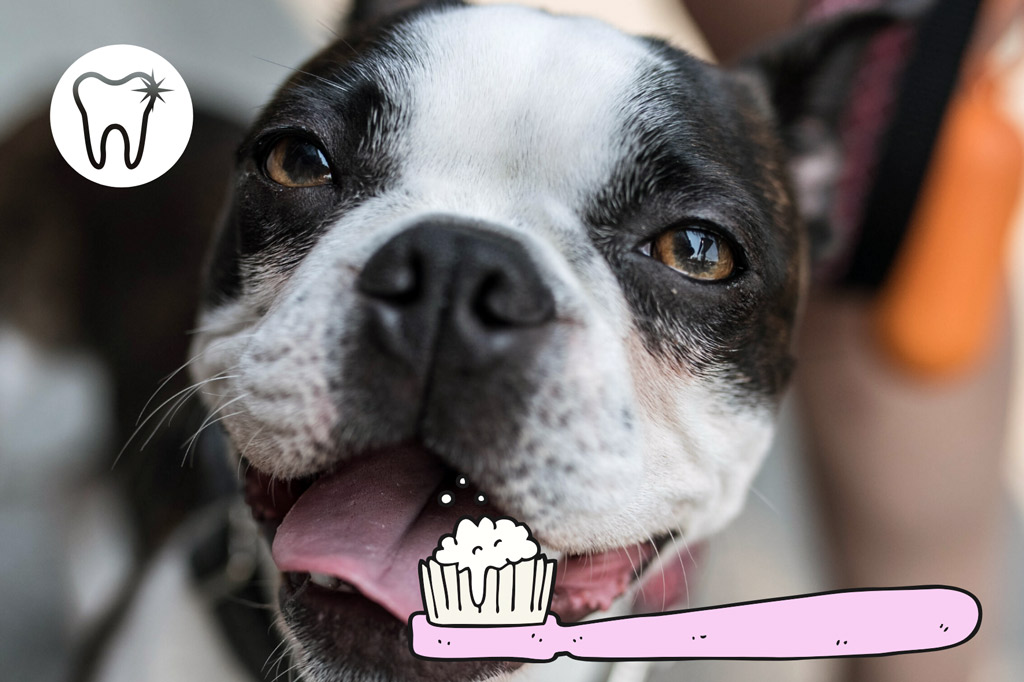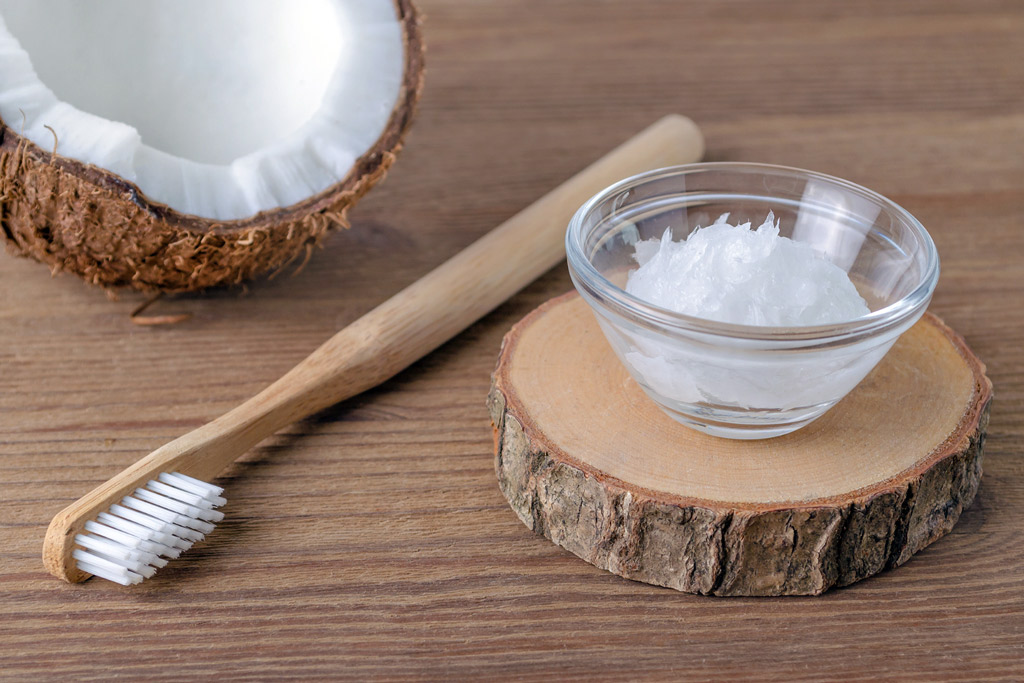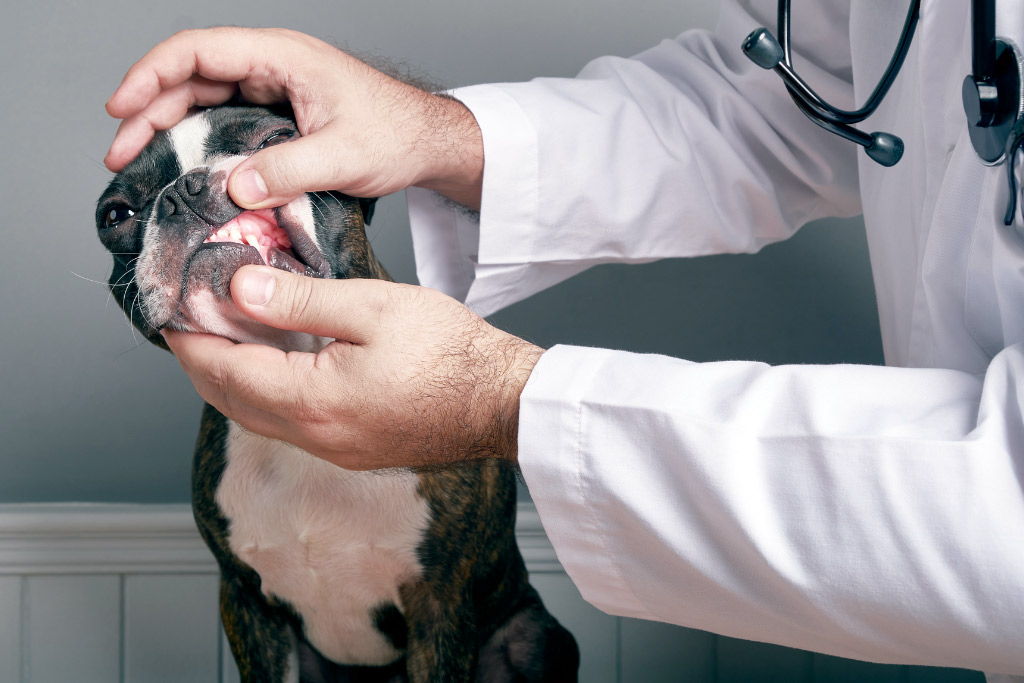
Brushing your Boston Terrier’s teeth is probably the most effective way to prevent dental disease, bad breath and tooth decay. Unfortunately, it’s not always the easiest thing to do.
If you’re not sure how to brush Boston Terrier teeth, and you haven’t established a routine yet…
Don’t worry! I’ve got you covered 😉
It’s never too late to get started. Plus, you can take it slow to help your BT adjust whilst you praise her patience.
Continue reading to encourage your Boston Terrier’s dental health with regular brushing and other tips.
Dog Oral Health Essentials
Before getting started on how to clean your Boston Terrier’s teeth… Here are the two things you need for brushing:
Dog Toothbrush
There are two options to consider:
- Canine toothbrush: A dog toothbrush is similar to human toothbrushes, but are smaller and have much softer bristles. They also are dual-headed, which makes it easier to reach certain areas. Alternatively, you can use a child’s soft toothbrush.
- Finger toothbrush: A dog finger toothbrush, which fits over your finger and makes cleaning those hard-to-reach areas easier.
* You can find all these options in Amazon.
Dog Toothpaste
There are many dog-friendly kinds of toothpaste that are specifically for dogs that have been made with ingredients that are safe for them to swallow.
Obviously your BT cannot rinse her mouth or spit out the toothpaste. That’s why you want to make sure that the toothpaste is specially designed for dogs.
Insider Tip: Most human toothpastes contain fluoride, which is extremely toxic—and sometimes fatal—to dogs. So always go for or use a dog-friendly toothpaste.
Commercial dog toothpaste (available in Amazon) comes in several flavours such as poultry and beef. Check their ingredients for the most natural option.
For a homemade alternative to clean your dog’s mouth without “toothpaste”, you can instead use raw coconut oil (in solid form and cooking graded). This is a wonderful option to keep your dog’s teeth and gums clean and free from the formation of plaque and bacteria.

How to Brush Boston Terrier Teeth
You want to start slow but also start this routine as soon as possible.
The best time to establish a solid brushing routine, like any grooming routine, is when your Boston Terrier is young. However, it’s never too late to keep your dog’s teeth healthy!
Brushing your pup’s teeth doesn’t have to be an impossible task to accomplish. The key is to break the process down into steps and gradually work up to the actual brushing!
Follow these simple steps to make brushing easier, plus less stressful for you both:
#0 – Select a Good Time
Before anything else, select a good time to get your pooch acquainted with you brushing her teeth.
Make sure your dog is relaxed and perhaps even a little drowsy. i.e. you don’t want her to be too energetic.
#1 – Get Ready
Spend at least a week getting your Boston Terrier “ready” for brushing her teeth by massaging her lips with your finger in a circular motion once or twice a day.
#2 – Get Her Used To It
For the next week or so, move to her teeth and gums, massaging with your finger in a similar manner. Still no toothpaste or toothbrush yet.
#3 – Toothpaste Test
After she gets more comfortable, smudge a very small amount toothpaste or coconut oil on her lips. Spend at least a few days getting her accustomed to the taste.
#4 – Toothbrush Test
Now it’s time to introduce a piece of gauze and rub it against the teeth. Make small, circular motions on her teeth.
After your pooch accepts that, you can move on to a finger toothbrush, and finally to a dog toothbrush with soft bristles. But don’t rush the process, be patient with your furry friend.
It’s natural that your Boston will get fussy during this procedure. If she does, take a break and gently stroke your pooch, soothing her discomfort.
Repeat the next day, until your pup is once again comfortable with you touching around her mouth area.
#5 – A Few Teeth at The Time
Then, add a small amount of toothpaste or coconut oil to the dog toothbrush. Brush gently, in circular motions.
Don’t aim to clean all her mouth at once. First, try working on a few teeth at a time. Focus on the back teeth and the outsides of your dog’s teeth, as those tend to be dirtiest.
When the time is right, pull her lips and cheek back to gain access to her back teeth.
#6 – Regular Teeth Brushing Practice
Finally, it’s time to establish a regular tooth brushing routine. Remember to brush the back teeth where plaque and tartar have an increased tendency to accumulate.
Also, don’t forget to praise your pup’s patience and good behaviour throughout this process. It’s a great way for her to repeat positive actions.
Try to make this time between you and your Boston Terrier as enjoyable as possible. You don’t want her to get anxious every time you brush her teeth!
Ideally, you want to brush your Boston Terrier’s teeth every night, or at least two times a week. Bostons with dental problems may need more frequent dental care. So, check with your vet to determine the best practice for your pooch.

How to Keep a Boston Terrier’s Mouth Clean
How fast your Boston Terrier’s teeth get dirty depends on several factors:
- Genetics.
- Your dog’s diet.
- The amount of saliva your dog produces.
- Your dog’s age (the risk of dirty teeth dramatically increases with age).
So, how can you keep your BT’s mouth clean?
#1 – Keeping Regular Teeth Brushing Routine
Since your Boston cannot do it by herself, she depends on you to brush her teeth regularly.
Taking the time to take care of your dog’s dental hygiene now will assure good oral health and may prevent more serious dental problems as she ages.
#2 – Following a High-Quality Diet
Feeding your Boston Terrier a high-quality diet that is species-appropriate also helps to keep her good oral health.
Raw bones, for example, are a great way to strengthen your dog’s gum in a natural manner.
Whole foods with natural ingredients often contain enzymes and other supplements that help break down unwanted build-up on teeth.
Although tartar buildup can be reduced following a high-quality diet, it doesn’t mean that regular brushing is not required!
Finally, avoid high-carbohydrate diets – or those containing rice, corn, wheat, tapioca, or potatoes. These increase plaque and tartar build-up.
#3 – Dental Chews
Chewing is a great way to promote oral health.
Dog chew toys are not only great to keep your dog busy, but also help promote healthy teeth and gums. Also, if your pup is teething, they provide pain relief.
There are tons of indestructible chew toys out there (like Nylabone Flavored Bone – Amazon link). They are made with tough but safe rubber that will keep your dog away from chewing anything else!
Apart from chew toys, there are two dental chews options:
- Rubber dental chews: A rubber dental chew is made specifically to clean your dog’s teeth. The chewing action scrapes off plaque and tartar.
- Eatable dental chews: There’s a wide selection of dental chews available in Amazon. These are filled with ingredients (like enzymes) to help prevent further build-up and make your dog’s breath fresher. However, have a look at the ingredient list since some contain questionable ingredients.

Boston Terrier’s Dental Health
According to the American Veterinary Dental Society, over 80% of dogs have some kind of dental issue by age 3. As a result, these dogs will very likely have some early evidence of periodontal disease.
It starts with plaque that hardens into tartar and progresses to infection of the gums and roots of the teeth. If left untreated, your Boston Terrier can lose her teeth and be in danger of damaging her kidneys, liver, and heart muscles.
Apart from periodontal disease, Boston Terriers can suffer from other dental problems including:
- Gum disease.
- Halitosis (bad breath).
- Gingivitis.
- Tooth fractures.
So, what are the warning signs to look out for?
- Bad breath.
- Excessive drooling.
- Swollen or bleeding gums.
- Loose or missing teeth.
- Excessive tartar build-up (you are not able to clean it).
If you notice any of these symptoms, pay a visit to your vet.
Sadly, not everything can be prevented, which is why having dog insurance can especially help you save on vet bills. With Petplan pet insurance, you get the coverage, support and resources you need to be the best pet parent ever.
In Summary
Regular brushing, plenty of fresh and filtered water, a high-quality diet and the occasional dental chew could be enough to ensure a healthy set of teeth for years to come. And avoid expensive professional dental cleaning too!
For more BT grooming tips, check out How to Groom a Boston Terrier – Basic Guide blog post.
